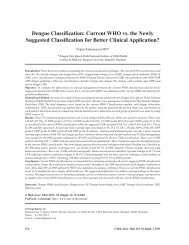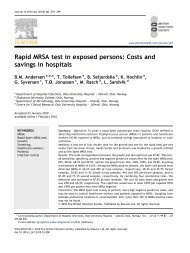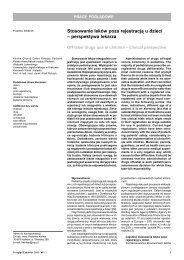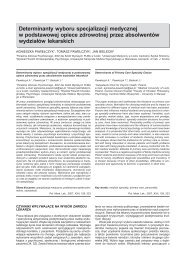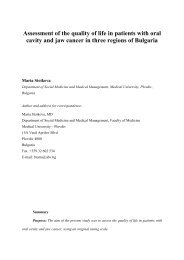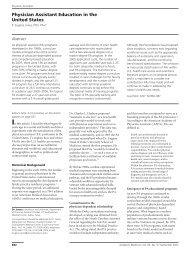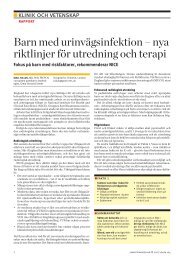prevalence of highly active antiretroviral therapy ... - Labome.Org
prevalence of highly active antiretroviral therapy ... - Labome.Org
prevalence of highly active antiretroviral therapy ... - Labome.Org
Create successful ePaper yourself
Turn your PDF publications into a flip-book with our unique Google optimized e-Paper software.
221<br />
Yeweyenhareg Feleke, Daniel Fekade, Yared Mezegebu, 2012. Ethiop Med J, Vol. 50, No. 3<br />
ORIGINAL ARTICLE<br />
PREVALENCE OF HIGHLY ACTIVE ANTIRETROVIRAL THERAPY ASSOCIATED<br />
METABOLIC ABNORMALITIES AND LIPODYSTROPHY<br />
IN HIV INFECTED PATIENTS<br />
Yeweyenhareg Feleke*, MD, CSIM, MPhil 1 , Daniel Fekade, MD, CSIM, MSc 2 , Yared Mezegebu, MD 3<br />
ABSTRACT<br />
Background: Highly <strong>active</strong> <strong>antiretroviral</strong> <strong>therapy</strong> (HAART) improves the longevity <strong>of</strong> HIV patients. However, the<br />
side effect <strong>of</strong> the drugs leads to development <strong>of</strong> chronic metabolic and cardiovascular complications.<br />
Objective: The aim <strong>of</strong> the study was to detemine the <strong>prevalence</strong> and risk factors <strong>of</strong> the metabolic abnormalities<br />
and lipodystrophy among adult Ethiopian HIV infected patients on ART for one year and above.<br />
Methods: A cross-sectional study was conducted among HIV infected patients on HAART for one year or more,<br />
attending the ART clinics <strong>of</strong> Tikur Anbessa Specialized hospital in Addis Ababa. A total <strong>of</strong> consecutive 356 HIV<br />
infected patients volunteered to participate in the study from July 2007 to January 2008. Data was collected using<br />
clinical interview technique on structured questionnaires and physical examination <strong>of</strong> the patient, 319 had biochemical<br />
tests performed.<br />
Results: Three hundred fifty six HIV patients; 261 (73.1%) females and 95 (26%) males were studied. Two hundred<br />
nine (59.7%) patients were on Stavudine based and 135 (41.3%) were on Zidovudine based ART <strong>therapy</strong>. The<br />
overall <strong>prevalence</strong> <strong>of</strong> lipodystrophy was 68.3% (243), <strong>prevalence</strong> <strong>of</strong> hyperlipademia among 319 HIV patient was<br />
56.9%. Among these, the <strong>prevalence</strong> <strong>of</strong> hypercholesterolemia was 38.2 %, high LDL cholesterol was 54.2%, hypertryglyceredimeia<br />
was 15.2%. Fasting hyperglycemia was 17.8 %, (IFG in 10.9% and overt diabetes in 6.9%). History<br />
<strong>of</strong> smoking was significantly associated with lipoatrophy and lipohypertrophy. ART regimen d4T was significantly<br />
associated with lipoatrophy. Duration <strong>of</strong> ART treatment >1yr was significantly associated with both lipoatrophy,<br />
lipohypertrophy and hypertriglyceredemia.<br />
Conclusions and Recommendations: Lipodystrophies occurred in majority <strong>of</strong> patients on ART treatment for<br />
longer than one year, hyperlipaedemia and hyperglycaemia were also seen commonly in Ethiopian HIV patients<br />
on HAART. We recommend careful monitoring <strong>of</strong> metabolic abnormalities, examination <strong>of</strong> the patient for early<br />
detection <strong>of</strong> the side effect, change <strong>of</strong> the <strong>of</strong>fending agents management <strong>of</strong> metabolic abnormalities.<br />
Key words; diabetes mellitus , HAART, HIV, hyperlipaedemia, Impaired Fasting Glucose, Lipodystrophies, Metabolic<br />
abnormalities.<br />
INTRODUCTION<br />
Highly Active Antiretroviral Therapy (HAART) is<br />
known to cause a metabolic syndrome consisting <strong>of</strong><br />
morphologic and metabolic abnormalities. The morphologic<br />
manifestations consist <strong>of</strong> the development<br />
<strong>of</strong> lipoatrophy and/or lipohypertrophy, and the metabolic<br />
abnormalities include insulin resistance, hyperinsulinemia,<br />
hyperglycemia, hyperlipidemia (1, 2, 3).<br />
It has been suggested that protease inhibitors (PI)<br />
induced peripheral cellular lipolysis plays a key role<br />
in the development <strong>of</strong> lipodystrophy. Moreover, nucleoside<br />
reverse transcriptase inhibitors (NRTI) induced<br />
mitochondria toxicity may further explain the<br />
wasting and accumulation <strong>of</strong> body fat (4, 5).<br />
Exact <strong>prevalence</strong> and incidence <strong>of</strong> HIV /HAART<br />
associated lipodystrophy is not known, because <strong>of</strong><br />
lack <strong>of</strong> standard definition, difficulties in measurement<br />
and wide variations in assessment (6). Many<br />
*<br />
Corresponding author 1 Endocrinology and Metabolism Unit, Department <strong>of</strong> Internal Medicine, School <strong>of</strong> Medicine, College <strong>of</strong> Health Sciences,<br />
Addis Ababa University, yeweyenharegf@yahoo.com Addis Ababa, Ethiopia<br />
2<br />
Division <strong>of</strong> Infectious Disease, Department <strong>of</strong> Internal Medicine, School <strong>of</strong> Medicine, College <strong>of</strong> Health Sciences, Addis Ababa University,<br />
Addis Ababa, Ethiopia<br />
3<br />
Department <strong>of</strong> Internal Medicine, School <strong>of</strong> Medicine, College <strong>of</strong> Health Sciences, Addis Ababa University, Addis Ababa, Ethiopia
222<br />
studies have attempted to establish the <strong>prevalence</strong> <strong>of</strong><br />
HIV associated lipodystrohy, which has been estimated<br />
to be between 2 to 84 % in patients who were<br />
on Protease Inhibitor containing HAART regimens<br />
(1, 7, 8). Lipoatophy is linked to <strong>antiretroviral</strong> treatment<br />
(ART) and in particular stavudine (d4T) and in<br />
a lesser degree zidovudine (AZT) and didanosine<br />
(ddl ) (9). Based on findings <strong>of</strong> epidemiological studies,<br />
the syndrome is thought to develop after 10-18<br />
months <strong>of</strong> HAART (8). The etiology <strong>of</strong> these metabolic<br />
abnormalities remains unknown, although it<br />
appears to be multifactorial in origin and there are<br />
many identified risk factors: including PI, NRTI<br />
and NNRTI treatment, age, gender, duration and<br />
severity <strong>of</strong> HIV disease, viral load, duration <strong>of</strong> ART,<br />
and body mass index (10, 11,12 ).<br />
Diabetes is much more prevalent in HIV subjects<br />
with lipodystrophy than in those without it (13, 14).<br />
A study has shown that the rate <strong>of</strong> incident <strong>of</strong> diabetes<br />
was 4.7 cases per 100 people- years among HIV<br />
infected men compared with 1.4 cases per 100 person’s<br />
year among HIV seronegative men (15). Metabolic<br />
abnormalities commonly seen in the lipodystrophy<br />
syndrome include hyperinsulinemia, insulin resistance,<br />
hyperglycemia, hypertriglyceridemia and<br />
hypercholesterolemia (16, 17).<br />
In Ethiopia, fee based ART program was <strong>of</strong>ficially<br />
launched by the government in July 2003. In 2005,<br />
Ethiopia launched free ART program, over 246,347<br />
were initiated on ART by the end <strong>of</strong> February 2010<br />
and about 532 treatment sites are now providing<br />
HIV care and treatment services in all regions (18,<br />
19). So far, to the best <strong>of</strong> author (s) knowledge, no<br />
published data are available to evaluate the magnitude<br />
<strong>of</strong> metabolic abnormalities and lipodystrophy in<br />
HIV patients in Ethiopia.<br />
The aim <strong>of</strong> the study was to determine the <strong>prevalence</strong><br />
and risk factors <strong>of</strong> the metabolic abnormalities and<br />
lipodystrophy among adult Ethiopian HIV infected<br />
patients who had been on ART for at least one year<br />
and more.<br />
PATIENTS AND METHODS<br />
The study design was cross-sectional among HIV<br />
infected adult patients on HAART. The reference<br />
populations were all HIV patients coming to ART<br />
clinics <strong>of</strong> Tikur Anbessa Specialized University Hospital.<br />
The Tikur Anbessa Specialized hospital<br />
launched free ART treatment in March 2005. Until<br />
the study period, a total <strong>of</strong> 3,710 HIV patients were<br />
registered. Among these 2,361 patients were started<br />
on ART. Those HIV patients with history <strong>of</strong> hyperlipaedemia,<br />
hypertension and diabetes mellitus before<br />
the initiation <strong>of</strong> HAART, patients on HAART<br />
less than one year, age less than 18 years, critically<br />
ill patients and non- volunteers were excluded from<br />
the study.<br />
The target populations were patients who had taken<br />
HAART for one year or more and attending the ART<br />
clinics <strong>of</strong> Tikur Anbessa Specialized Hospital. Sample<br />
size determination was based on the formula with<br />
single population proportion (N=Z2α/2P (1-p) /D).<br />
The margin <strong>of</strong> error <strong>of</strong> 0.05, Confidence level <strong>of</strong> 1.96<br />
and <strong>prevalence</strong> <strong>of</strong> side effects varying from 5-50% to<br />
get the maximum sample size. Thus the sample size<br />
calculated to be 384. Consecutively 356 HIV patients<br />
volunteered to participate in the study were included.<br />
The study was conducted from July 2007 to January<br />
2008.<br />
The data was collected by a physician and ART<br />
trained nurses after adequate training on data collection<br />
and interpretation <strong>of</strong> clinical findings. Data was<br />
collected using clinical interview, structured questionnaires,<br />
and physical examination <strong>of</strong> the patient.<br />
Five milliliter <strong>of</strong> blood was used for determination<br />
blood lipid pr<strong>of</strong>iles for total cholesterol, low density<br />
lipoprotein (LDL) cholesterol, high density lipoprotein<br />
(HDL) cholesterol, triglycerides and fasting glucose<br />
level.<br />
The analysis performed by senior laboratory technologist<br />
in research laboratory <strong>of</strong> Endocrinology and<br />
metabolism Unit using Photometer 5010, Semi- automated<br />
single beam filter photometer, Robert Rifel<br />
KG, Berlin, Germany. We applied an end point colorimetric<br />
method and developed LG chart and West<br />
gard rules for quality assessment.<br />
In addition, data Quality was assured by training <strong>of</strong><br />
nurses who have ample experience on ART management,<br />
preparing structured questionnaires and supervision<br />
<strong>of</strong> the research activities by the senior collaborators<br />
<strong>of</strong> the project. The following standard definitions<br />
were used in the current study.<br />
HAART related Lipoatrophy was mean when subcutaneous<br />
fat depletion and wasting most commonly<br />
around the face especially the cheeks below the zygomas,<br />
the extremities, and gluteal regions, veins<br />
appears more prominent in fat depleted regions<br />
(8,10,16). HAART related Lipohypertrophy was
223<br />
mean when truncal obesity (central fat accumulation<br />
evidenced by increased waist circumference, in females<br />
>88 cms and males >102 cms), presence <strong>of</strong><br />
dorsocervical fat accumulation (buffalo Hump) and<br />
breast enlargement in female and gynecomastia in<br />
male was also be taken as indicators <strong>of</strong> lipohypertrophy<br />
(8,10,16). Hypertension was considered when<br />
blood pressure was > 140/90 mm/Hg.<br />
Hyperlipidemias was defined in the presence <strong>of</strong> one<br />
<strong>of</strong> the following: Total cholesterol > 200 mg/dl, HDL<br />
< 35 mg/dl, or LDL Cholesterol values >150 mg/dl,<br />
Serum Triglyceride levels > 150mg/dl. Hyperglycemia<br />
was defined when Fasting plasma Glucose Levels<br />
was >100 mg/dl. Impaired Fasting Glucose (IFG)<br />
means when fasting plasma Glucose is between 100<br />
-125 mg/dl, Diabetes mellitus was defined when<br />
Fasting plasma Glucose Levels was 126 mg/dl or<br />
more (20 ).<br />
Data was entered into the computer and analyzed<br />
using SPSS. 15.0 version. Descriptive analysis was<br />
done; chi square tests and regressions used to assess<br />
the associations <strong>of</strong> variables. The Ethical clearance<br />
<strong>of</strong> the research was obtained from the Research and<br />
Publication Committee (FRPC), Faculty <strong>of</strong> Medicine<br />
<strong>of</strong> Addis Ababa University. The study participants<br />
were informed about the risk and benefits <strong>of</strong> the<br />
study; the right to withdraw from the study and no<br />
impact on their treatment and care if they refuse to<br />
take part in the study. Written informed consent was<br />
obtained from all participants. Data collection, analysis<br />
and write up were kept confidential. Those patients<br />
identified with metabolic abnormalities were<br />
referred to physicians and diabetic clinic <strong>of</strong> the hospital<br />
for follow up and management.<br />
RESULTS<br />
A total <strong>of</strong> 356 patients were included in to the study;<br />
among them 319 had complete biochemical studies.<br />
As shown in Table 1: 261 (73.1%) were females and<br />
95 (26%) were males; the mean age for females was<br />
34.5 + 7.65 (range: 20-60 years) and for males 40.24<br />
+ 9.22 (range:18-65). Eighty one percent <strong>of</strong> the study<br />
participants were in stage III and Stage IV HIV diseases<br />
(58.8% and 22.9 %, respectively). One hundred<br />
twenty eight (39.9%) patients had been on HAART<br />
for 12-18 months, 81 (25.2%) from 19-24 months<br />
and 112 (34.9%) more than 24 months. The overall<br />
<strong>prevalence</strong> <strong>of</strong> lipodystrophy in 356 patients was<br />
68.3% (243). The <strong>prevalence</strong> <strong>of</strong> lipoatrophy was<br />
57.3% (204). The <strong>prevalence</strong> <strong>of</strong> lipohypertophy was<br />
46.3% (165), among this buffalo hump occurred in<br />
78 (22%) <strong>of</strong> patients.<br />
Table 1: Baseline Characteristics <strong>of</strong> 356 HIV patients<br />
on HAART for one year and above, at ART clinics<br />
<strong>of</strong> Tikur Anbessa Specialized Hospital, July 2007 to<br />
January 2008.<br />
Variables Number Frequency<br />
(% )<br />
Sex<br />
Male 95 26.7<br />
Female 261 73.1<br />
Martial Status<br />
Single 96 27<br />
Married 153 43.1<br />
Divorced 54 15.2<br />
Widowed 52 14.6<br />
Ethnics group<br />
Amhara 194 54.6<br />
Oromo 76 21.4<br />
Tigrian 41 11.5<br />
Gurage 41 11.5<br />
Others 3 0.8<br />
Duration <strong>of</strong> HAART<br />
treatment<br />
12 -18 months 128 39.9<br />
19 -24 months 81 25.2<br />
> 24 months 112 34.9<br />
WHO HIV staging<br />
Stage I 7 2.0<br />
Stage II 58 16.4<br />
Stage III 208 58.8<br />
Stage IV 81 22.9<br />
Lipodystrophy 243 68.3<br />
Lipoatrophy* 204 57.3<br />
Face 116 32.6<br />
Extremities 184 51.7<br />
Buttock 63 17.4<br />
Prominent superficial 85 23.9<br />
veins and muscules<br />
Lipohypertrophy* 165 46.3<br />
Dorso cervical 78 21.9<br />
Breast enlargement 66 18.5<br />
Fat accumulation<br />
around the abdomen<br />
146 41.0
224<br />
As shown in Table 2, the mean waist circumference<br />
<strong>of</strong> the 356 study participant was 67.9 + 24.45; and<br />
hip circumference was 71.43 + 25.64. Among the<br />
patients on HAART for a year and above 51 <strong>of</strong> female<br />
participants had increased waist circumference<br />
above 88 cms compared to 4 male patients who had<br />
increased waist circumference above 102 cms.<br />
Among possible risk factors for metabolic abnormalities<br />
in HIV patients on HAART treatment, 24<br />
(6.2%) <strong>of</strong> them had family history <strong>of</strong> diabetes, 10<br />
(2.8%) had family history <strong>of</strong> hypertension, only 3<br />
had family history <strong>of</strong> cardiac diseases (Table 3).<br />
Table 2: Anthropometric and Blood pressure measurement <strong>of</strong> 356 HIV patients on HAART for one year and<br />
above, at ART clinics <strong>of</strong> Tikur Anbessa Specialized Hospital, July 2007 to January 2008.<br />
Variables<br />
Number Mean + SD Minimum- maximum<br />
(Frequency<br />
%)<br />
Height<br />
Male 95 168.46 (10.18) 110 - 192<br />
Female 261 153.60 (7.48) 105-186<br />
Weight<br />
Male 95 63.05 ( 12.83) 38-112<br />
Female 261 56.04 (9.71) 32 -102<br />
BMI<br />
Male 95 22.1(6.3)<br />
Female 261 23.2(5.2)<br />
Waist Circumference<br />
(WC) cms<br />
67.9 (24.45) 27 -131<br />
Male – 102 4 (4.3) - -<br />
Female < 88 cms 205 (80.1) - -<br />
>88 cms 51 ( 19.9) - -<br />
Hip Circumference ( HP) 71.43 (25.64) 27-123<br />
Male<br />
Female<br />
Blood pressure<br />
Systolic 356 112.01 (19.73) 40-200<br />
Diastolic 356 71.42 (14.30) 50-120
225<br />
Table 3: Risk Factors for metabolic abnormalities in 356 HIV Patients on HAART for one year and above,<br />
at ART clinics <strong>of</strong> Tikur Anbessa Specialized Hospital, July 2007 to January 2008.<br />
Risk factors Number Frequency<br />
(% )<br />
History <strong>of</strong> alcohol consumption 8 23<br />
History <strong>of</strong> Smoking 24 6.8<br />
Family hx <strong>of</strong> DM 24 6.2<br />
Family hx <strong>of</strong> HTN 10 2.8<br />
Family hx <strong>of</strong> cardiac illness 3 0.8<br />
Type <strong>of</strong> HAART treatment<br />
1. d4T (30)/3TC/NVP 118 33.1<br />
2. d4T (40)/ 3TC/NVP 38 10.7<br />
3. d4T (30)/3TC/EFV 49 13.8<br />
4. d4T (40)/3TC/EFV 16 4.5<br />
5 . ZDV/3TC/NVP 86 24.2<br />
6. ZDV/3TC/EFV 49 13.8<br />
Initial CD4 count<br />
< 100 187 53<br />
100- 200 151 42<br />
.> 200 15 4.2<br />
CD4 count during study period (> 1 yr. on<br />
HAART)<br />
< 100 16 4.8<br />
100 - 200 90 27.1<br />
> 200 226 68.1<br />
One hundred eighteen (33%) <strong>of</strong> 351 patients were on<br />
Stavudine-Lamuvidine-Nevarapine regimen, 86<br />
(24%) <strong>of</strong> 351 patients were on Zidovudine - Lamuvidine<br />
- Nevarapine regimen, 49 (13.8%) were on<br />
Zidovudine- Lamuvidine -Effavirenz. Only 16 patients<br />
were on Stavudine -Lamuvidine -Effavirenz<br />
regimen. Overall 209(58.7 %) <strong>of</strong> them were on stavudine<br />
based and135 (41.3 %) <strong>of</strong> them were on zidovudine<br />
based treatment. Among the total patients<br />
51 (14.35%) <strong>of</strong> them had history <strong>of</strong> change <strong>of</strong> medications<br />
to other regimens.<br />
As shown in Table 4, the overall <strong>prevalence</strong> <strong>of</strong> Hyperlipademia<br />
in 319 HIV patients on HAART was<br />
56.9%. Among these the <strong>prevalence</strong> <strong>of</strong> hypercholesterolemia<br />
was 38.2 % , Hypertryglyceredimeia was<br />
15.2%, Low HDL cholesterol was 42.3%, high LDL<br />
cholesterol was 54.2%. Prevalence <strong>of</strong> Impaired Fasting<br />
Glucose (IFG) was 10.9% and diabetes mellitus<br />
was 6.9%. Overall the <strong>prevalence</strong> <strong>of</strong> hyperglycemia<br />
in HARRT treated HIV patients was 17.8 %.
226<br />
Table 4 : Frequency and Mean <strong>of</strong> Biochemical and Metabolic tests in 319 HIV patients on HAART for<br />
one year and above, at ART clinics <strong>of</strong> Tikur Anbessa Specialized Hospital, July 2007 to January 2008.<br />
Variables Number % Mean + SD (Range)<br />
Cholesterol (mg/dl) 189.52 + 61.98 (40- 811)<br />
< 200 197 61.8<br />
> 200 122 38.2<br />
Triglycerides<br />
178.35 + 109.77 (34-850)<br />
(mg/dl)<br />
< 150 270 84.6<br />
> 150 49 15.4<br />
HDL (mg/dl) 44.42 +17.50 (18 – 181)<br />
< 40 40 42.3<br />
> 40 184 57.7<br />
LDL 108 .48 + 49..31 (25 -576)<br />
< 150 146 45.8<br />
> 150 173 54.2<br />
FBS mg/dl 93.68 + 43.98 (51 -417)<br />
< 100 263 82.2<br />
100- 125 35 10.9<br />
> 126 22 6.9<br />
BUN (mg/dl) 319 26.07 (13.82), 10.142<br />
Creatinine (mg/dl) 319 0.74 ((0.65), 0.1 -7<br />
SGOT 319 29.37 (13.8), 8 -103<br />
SGPT 319 28.08 (13.4), 8- 95<br />
Alkaline phosphatase<br />
319 193 .76 (103 .11), 19- 1200<br />
As shown in Tables 5a and Table 5b, sex <strong>of</strong> the patient<br />
was significantly associated with LDL cholesterol<br />
(P = 0.002) and lipohypertrohy (P = 0.0001) but<br />
showed no association with the others metabolic abnormalities.<br />
History <strong>of</strong> smoking is significantly associated<br />
with lipoatrophy (P=0.04) and lipohypertrophy<br />
(P=0.05). ART regimen is significantly associated<br />
with lipoatrophy (P = 0.03).<br />
Duration <strong>of</strong> ART regimen was significantly associated<br />
with both lipoatrophy (P=0.01), lipohypertrophy<br />
(P=0.03), and hypertriglyceridemia (P= 0.006). Age<br />
<strong>of</strong> the patient was significantly associated with hyperglycemia<br />
(P=0.04), and hypercholesterolemia (P<br />
= 0.003).
227<br />
Table 5 a. Associations between Risk factors and lipodystrophy in 356 HIV patients on HAART for one year<br />
and above, at ART clinics <strong>of</strong> Tikur Anbessa Specialized Hospital, July 2007 to January 2008.<br />
Risk factors Total Lipoatrophy<br />
X 2 test<br />
P-value<br />
Lipohypertrophy<br />
X 2 test<br />
P-value<br />
Sex Males 95 2.43 0.14 13.04 0.0001<br />
Females<br />
261<br />
History <strong>of</strong> smoking: 24 6.06 0.01 4.7 0.03<br />
Yes<br />
No 330<br />
Female<br />
283 0.55 0.49 11.4 0.001<br />
WC > 88 cms.<br />
< 88 cms. 67<br />
ART Regimen<br />
Stavudine<br />
209 4.9 0.03 0.06 0.83<br />
based<br />
Zidovudine<br />
147<br />
based<br />
Duration <strong>of</strong> ART treatment<br />
12-18 months 128 8.4 0.01 6.6 0.03<br />
19-24 months<br />
> 24 months<br />
81<br />
112<br />
Table 5 b. Associations between Risk factors and metabolic abnormalities in 319 HIV on HAART for one year<br />
and above, at ART clinics <strong>of</strong> Tikur Anbessa Specialized Hospital , July 2007 to January 2008.<br />
Risk factors<br />
Total<br />
Fasting Plasma<br />
glucose<br />
X 2 test<br />
p-value<br />
Total Cholesterol<br />
X 2 test<br />
P-value<br />
Age >50 years 28 5.04 0.04 9.7 0.003<br />
88 cms. 255 4.9 0.03 6.3<br />
< 88 cms. 59<br />
Stage <strong>of</strong> HIV<br />
Stage I&II 58 4.0 0.04 0.09 0.17<br />
Stage III & IV 260<br />
Sex Males 82 0.15 0.70 11.1 0.002<br />
Females 237<br />
Female<br />
WC > 88 cms. 255 6.2 0.02 4.9 0.02<br />
< 88 cms. 59<br />
Duration <strong>of</strong> ART<br />
treatment<br />
12-18 months 114 10.2 0.006 0.9 0.6<br />
19-24 months<br />
> 24 months<br />
74<br />
97
228<br />
DISCUSSION<br />
Barbaro and Lacobellis stated that about pathogenesis<br />
<strong>of</strong> HAART associated metabolic syndrome and its<br />
atherogenic pr<strong>of</strong>ile is complex. It is stated, several<br />
factors are involved including direct effects <strong>of</strong><br />
HAART on lipid metabolism, endothelial and adipocyte<br />
cell function, activation <strong>of</strong> proinflammatory<br />
cytokines and mitochondrial dysfunction (21). Mitochondrial<br />
toxicity <strong>of</strong> NRTIs leads to metabolic abnormalities.<br />
Stavudine- didanosine- zidovudine are<br />
associated with greater toxicity than newer agents<br />
like lamuvidine- abacavir- ten<strong>of</strong>ivir (7).<br />
In this study, among ART patients with metabolic<br />
abnormalities the overall <strong>prevalence</strong> <strong>of</strong> lipodystrophy<br />
was 68.3%, lipoatophy was 57.3%, and lipohypertrophy<br />
was 46%. This was similar to a report in<br />
a cohort <strong>of</strong> African HIV patients from Senegal; the<br />
<strong>prevalence</strong> <strong>of</strong> mild to sever lipodystrophy affected<br />
65% <strong>of</strong> patients on stavudine - zidovudine - protease<br />
inhibitors for 4-9 yrs <strong>of</strong> ART (22). Study from<br />
Rwanda showed that about 81% <strong>of</strong> patient on<br />
HARRT were on stavudin- lamuvidine - nevirapine<br />
regimen. Among these lipodystophy was observed in<br />
69.6% in those receiving HARRT for more than 72<br />
weeks (23).<br />
Our study showed higher <strong>prevalence</strong> <strong>of</strong> lipodystrophy<br />
compared to Rwandan study by Van Griensven<br />
et al. Which showed the <strong>prevalence</strong> <strong>of</strong> lipodystrophy<br />
in 34% and the <strong>prevalence</strong> <strong>of</strong> lipoatrophy was<br />
three times higher when taking d4T compared with<br />
AZT containing regimens (31.4% vs 10.3%) (24 ).<br />
Others reported <strong>prevalence</strong> <strong>of</strong> lipodystrophy in 0-<br />
38% patients treated with NRTI (25, 26). In the current<br />
study, the <strong>prevalence</strong> <strong>of</strong> lipodystrophy is increasing<br />
with increasing duration <strong>of</strong> HAART treatment<br />
similar to that <strong>of</strong> report by Merceir S et al.<br />
(22). Other report also showed that additional 6<br />
months <strong>of</strong> treatment with HAART is associated with<br />
a 45% increase risk <strong>of</strong> lipodystrophy (27).<br />
Dyslipaedemia is common in persons with HIV infection.<br />
The typical pattern is elevated total cholesterol<br />
and low density lipoprotein (LDL), decreased<br />
HDL cholesterol and elevated triglyceride (1,2,3).<br />
In our study, the overall <strong>prevalence</strong> <strong>of</strong> Hyperlipademia<br />
in 319 HIV patients on HAART was 56.9%.<br />
Among these we found out high <strong>prevalence</strong> <strong>of</strong> hypercholesterolemia<br />
(38.2%), low density lipoprotein<br />
(54.2%) and low <strong>prevalence</strong> <strong>of</strong> triglyceride (15.2% ).<br />
Gazzaruso et al showed a <strong>prevalence</strong> <strong>of</strong> hypertriglyceredimea<br />
in 59.3% <strong>of</strong> 553 HIV patients on HAART<br />
compared to our study which was only 15.2% (28).<br />
A study from South African identified significantly<br />
high level <strong>of</strong> cholesterol and triglyceride in HIV patients<br />
on first line ART regimen containing Stavudine<br />
(29).<br />
Diabetes mellitus is found to be three times more<br />
prevalent among patients receiving HAART (30).<br />
Impaired glucose tolerance and diabetes in these patients<br />
occurred due to primary mechanism <strong>of</strong> insulin<br />
resistance and hyperinsulinemia (31). Previous reports<br />
showed <strong>prevalence</strong> <strong>of</strong> hyperglycemia in 14 -24<br />
% <strong>of</strong> patients in HAART (32, 33) compared to our<br />
study (17.9%). In the current study <strong>prevalence</strong> <strong>of</strong><br />
Impaired Fasting Glucose (IFG) (10.9%) was low<br />
compared to Study by Mutimura et al. from Rawanda<br />
(18%) (23). Frank diabetes mellitus occured in 7% <strong>of</strong><br />
our patients compared to other reports (5-7% )(32-<br />
34). History <strong>of</strong> smoking occurred in 6.8% <strong>of</strong> our<br />
patients and it was significantly associated with lipoatrophy<br />
and Lipohypertrophy, which is one <strong>of</strong> the<br />
modifiable risk factor for lipodystrophy.<br />
This is a cross sectional study <strong>of</strong> patients at a tertiary<br />
medical center, which didn't include patients from<br />
primary care settings. Only few patients were examined<br />
by a physician, majority <strong>of</strong> patients were examined<br />
by trained nurses from the ART clinic, this<br />
might have some inter observer variations on physical<br />
examination <strong>of</strong> the patients.<br />
In conclusion: Lipohypertrophy and Lipoatrophy<br />
occurred in most patients on HARRT treatment, hyperlipaedemia<br />
and hyperglycaemia were seen in<br />
Ethiopian HIV patients on HAART. We recommend:<br />
Careful monitoring <strong>of</strong> metabolic abnormalities and<br />
examination <strong>of</strong> the patient for early detection <strong>of</strong> the<br />
side effect <strong>of</strong> <strong>highly</strong> <strong>active</strong> <strong>antiretroviral</strong> <strong>therapy</strong>.<br />
Changing the regimen <strong>of</strong> HAART to less toxic drugs<br />
and treating metabolic complications as early as possible.<br />
ACKNOWLEDGEMENTS<br />
We thank the Ethiopian Science and Technology<br />
Commission and Research Publication Office <strong>of</strong><br />
Addis Ababa University for funding the research, Dr.<br />
Wondwossen Amogne and Dr. Teshale Seboxa from<br />
Infectious disease Division , Department <strong>of</strong> Internal<br />
Medicine for management <strong>of</strong> the patients, Dr. Getu<br />
Debela for patient management, organizing and assisting<br />
in data collection Sr. Etenesh Kabtyemer, Sr.<br />
Marta Hiba, Sr. Lemelem Alemayehu for data collection,<br />
Ato Henoke Metaferia for data management.
229<br />
REFERENCES<br />
1. Ramezani A, Mohraz M, Yadeegarinia D, Baniffazl M, Gachkar L, Jam S, Aghakakani A, Eslamifar A,<br />
Yaghhmaie F, Nemati K, Velayati AA. Prevalence <strong>of</strong> Dyslipaedemia and Metabolic Abnormalities in HIV-<br />
Infected Patients. Acta Medica Iranica. 2009; 47(2); 83-88.<br />
2. Qaqish RB, Fisher E,Rublein J, Wohl DA. HIV–Associated lipodystrophy syndrome. Pharmaco<strong>therapy</strong> 2000;<br />
20 (1): 13-22.<br />
3. Cohan GR. HIV associated metabolic and morphologic abnormality syndrome: Welcome <strong>therapy</strong> may have<br />
unwelcome effects. Postgrad Med 2000; 107 (4) 141-6.<br />
4. Carr A, Samaras K, Burton S, Law M, Freund J, Chisholm DJ, Cooper DA. Pathogenesis <strong>of</strong> HIV-1 Protease<br />
inhibitors associated peripheral lipodystrophy, hyperlipaedemia and insulin resistance. Lancet 1998;351<br />
(9106): 871–75.<br />
5. Brinkman K, Smeitink JA, Romijn JA, Reiss P. Mitochondrial Toxicity induced by nucleoside –analogue<br />
reverse transcriptase inhibitors is a key factors in the pathogenesis <strong>of</strong> <strong>antiretroviral</strong>- related lipodystrophy.<br />
Lancet 1998; 354: 1112-115.<br />
6. Carole Leach –Lemens. Body fat changes in people with HIV: a Clinical Review. HATIP. 2009; 151: 6-13.<br />
7. Sweet DE. Metabolic Complications <strong>of</strong> Antiretroviral Therapy. International Aids Society- USA. Top HIV<br />
Med. 2005; 2; 70-74.<br />
8. Leow MKS, Addy CL, Mantzoros CS. Human Immunodeficiency Virus/ Highly Active Antiretroviral Therapy<br />
-Associated Metabolic Syndrome: Clinical Presentation, Pathophysiology and Therapeutic Strategies. The<br />
Journal <strong>of</strong> Clinical Endocrinology and Metabolism: Clinical Review. 2003; 88 (5): 1961-976.<br />
9. van Griensven J, Zachariah R, Rasschaert F, Atté E F, Reid T. Weight evolution in HIV-1 infected women in<br />
Rwanda after stavudine substitution due to lipoatrophy: comparison <strong>of</strong> zidovudine with ten<strong>of</strong>ovir/abacavir.<br />
Trans R Soc Trop Med Hyg, 101: 793-798, 2008. doi:10.1016/j.trstmh.2008.08.015<br />
10. Chen D, Misra A, Garg A. Lipodystrophy in Human Immuno deficiency Virus- Infected patients: Clinical<br />
Review 153. J Clin Endocrinol Metabo. 2002; 87: 4845-56.<br />
11. Sussman O, Salazar R, Galidez J, et al. Prevalence and Determinates <strong>of</strong> Metabolic Syndrome among Latin<br />
American HIV Infected patients on HAART: RAPID II Study.10 th , International Workshop on Adverse Drug<br />
Reactions and Lipodystrophy. Antitretoviral theraphy 2008; 13(S-4); A 79, P-75.<br />
12 Barbaro G, Barbarini G. Highly <strong>active</strong> <strong>antiretroviral</strong> theraphy –associated metabolic and cardiovascular risk.<br />
Chemotheraphy 2006; 52(4):161-5.<br />
13. Vigouroux C, Gharakhanian S, Salhi Y, Nguyen T, Chevenne D, Capeau J, Rozeenbaum W Diabetes, Insulin<br />
Resisitance and dyslipaedemia in lipodystrophic HIV–Infected patients on <strong>highly</strong> <strong>active</strong> <strong>antiretroviral</strong> theraphy<br />
(HAART). Diabetes Metab 1999; 25: 225 –32.<br />
14. Vigouroux C, Gharakhanian S, Salhi Y, Nguyen T, Chevenne D, Capeau J, Rozenbaum W. Diabetes, Insulin<br />
resistance and dyslipaedemia in lipodystrophy HIV infected patients on <strong>highly</strong> <strong>active</strong> antiretoviral theraphy<br />
( HAART). Diabetes Metab. 1999; 25: 225-32.<br />
15 Brown TT, Cole SR, Li X, Kingsely LA, Palella FJ, Riddeler SA, Visscher BR, Margolick JB, Dobs AS. Antiretroviral<br />
Theraphy and the <strong>prevalence</strong> and incidence <strong>of</strong> diabetes mellitus in the multicenter AIDS Cohort<br />
study. Arc Intern Med. 2005; 165 (10): 1179-84.<br />
16. Galli M, Ridolfo AL, Gervasoni C. Cardiovascular Disease risk factors in HIV infected patients in the<br />
HAART Era. Annals <strong>of</strong> the New York Academy <strong>of</strong> Science. 2006; 946: 200-13.<br />
17. Samaras K, Wanda H, Law M, Emery S, Cooper D, Carr A. Prevalence <strong>of</strong> metabolic syndrome in HIV infected<br />
patients receiving <strong>highly</strong> <strong>active</strong> <strong>antiretroviral</strong> <strong>therapy</strong> using IDF and ATP III criteria: association with<br />
insulin resistance, disturbed body fat compartmentalization, elevated C-re<strong>active</strong> protein, and (corrected) hypoadiponectemia.<br />
Diabetic care. 2007;30(1): 113-9.<br />
18. MOH- FHAPCO. Update <strong>of</strong> HIV Care and ART as <strong>of</strong> end <strong>of</strong> February, 2010, Available at:<br />
www.HAPCO.GOV.et<br />
19. Guidelines for Implementation <strong>of</strong> the Antiretroviral Therapy Programme In Ethiopia Federal HIV/AIDS Prevention<br />
and Control Office, Federal Ministry <strong>of</strong> Health July 2007, Addis Ababa, Ethiopia.
20. Report <strong>of</strong> the Expert Committee on the diagnosis and Classification <strong>of</strong> Diabetes Mellitus, Diabetes Care 2003;<br />
26:suppl 1 s5-s20.<br />
21. Barbaro G, lacobellis G. Metabolic Syndrome associated with HIV and Highly <strong>active</strong> <strong>antiretroviral</strong> theraphy.<br />
Curr Diab Rep. 2009; 9 (1): 37-42.<br />
22. Mercier S, Gueye NF, Counil A, Fonbonne A, Copin N, Ndiaya l , Dupuy AM, Cames C, Sow PS, Ndoye l ,<br />
Delaporte E, Simondone KB. Lipodystrophy and metabolic disorders in HIV -1 infected adults on 4 to 9 year<br />
<strong>antiretroviral</strong> theraphy in Senegal: a case control study. J Acquir Immune Defic Syndr 2009; 51 (2): 224-30.<br />
23. Mutimura E, Stewart A, Rheeder P, Crowther NJ. Metabolic function and <strong>prevalence</strong> <strong>of</strong> lipodystrophy in a<br />
population <strong>of</strong> HIV infected African subjects receiving <strong>highly</strong> <strong>active</strong> <strong>antiretroviral</strong> <strong>therapy</strong>. J Acquir Immune<br />
Defic Synd. 2007; 1:46 (4): 451-5.<br />
24. van Grienseven J,De NaeyerL, Mushi T, Ubarijoro S, Gashmba D, Gazille C, Zachariah R. High <strong>prevalence</strong> <strong>of</strong><br />
lipoatrophy among patients on stavudine containing first line <strong>antiretroviral</strong> theraphy regimens in Rwanda.<br />
Trans R Soc Trop Med Hyg. 2007; 101(8):793-8.<br />
25. Saint Marc T, Partisani M, Poizot-Martin, Rouviere O, Bruno F, Avella-neda R, Lang JM, Gastaut JA,<br />
Tourainne JL Fat distribution evaluated by computed tomography and metabolic aabnormalities in patients<br />
undergoing <strong>antiretroviral</strong> thweraphy : Preliminary results <strong>of</strong> LIPOCO Study. AIDS. 2000; 14: 37-49.<br />
26. Miller J, Carr A, Smith D, Emery S, Law MG, Grey P, Cooper DA; Lipodystrophy following <strong>antiretroviral</strong><br />
theraphy <strong>of</strong> primary HIV infection. AIDS. 2000: 14: 2406-2407.<br />
27. Martinez E, Mocr<strong>of</strong>t A, Garcia-Viejo MA, Perez -Cuevas JB,Blanco JL, Mollolas J, Blanchi L, Conget I,<br />
Blanchi J, Phillip A, Gatell JM. Risk <strong>of</strong> lipodystrophy in HIV -1 infected patients treated with protease in<br />
hibitors: A prospective cohort study. Lancet; 2001:357 592-8.<br />
28. Gazzarurso C, Sacchi P, Garzaniti, A, Fratino P, Bruno R, Fillice G. Prevalence <strong>of</strong> Metabolic Syndrome<br />
among HIV patients. Diabetic Care, Copy right ADA 2009. Available at: http://care.diabetesjournals.org/<br />
content/25/7/1253.<br />
29. Georgia JA, Venter WD, Van Deventer HE, Crowther NJ. A longitudinal study <strong>of</strong> the changes in the body fat<br />
and metabolic parameters in a South African population <strong>of</strong> HIV positive patients receiving an <strong>antiretroviral</strong><br />
therapeutic regimen containing stavudine. AIDS Res. Hum Retroviruses 2009; 25 (8): 771-81.<br />
30. Brown TT, Cole SR, Li X, Kingsley LA, Pallela FJ, Riddler SA, et al. Antiretroviral theraphy and the <strong>prevalence</strong><br />
and incidence <strong>of</strong> diabetes mellitus in the multicenter AIDS Cohort study. Arch Intern Med<br />
2005;165:1179-84.<br />
31. Johensen S, Dolan SE, Fitch KV, Killilea KM, Grinspoon SK. Absence <strong>of</strong> polycystic ovary syndrome features<br />
in human immuno deficiency virus infected women despite significant hyperinsulinemia and truncal adiposity.<br />
J Clin Endocrinol Metab. 2005; 90:5596-604.<br />
32. Green ML. Evaluation and management <strong>of</strong> dyslipedemia in patients with HIV INFECTION. J Gen Intern Med<br />
2002; 17(10): 797-810.<br />
33. Galli M, Ridolfo AL,Adorrni F, Gervisoni C, Ravasio L, Gianelli E, Piazza M, Vaccareza M, Montfortie AD,<br />
Morini M. Body habitus changes and metabolic alterations in protease inhibitor naieve HIV 1 infected patients<br />
treated with two nucleoside reverse transcriptase inhibitors. J Acquired Immune Defc Synd 2002; 29: 21-31.<br />
34. Mehta R, Loredo B, Sanudo ME, Herenandez-Jimenez S, Roddriguez- Carranza SI, Gomez- Perez FJ, Rull<br />
JA, Auilar-Salinas CA. Epidemiology <strong>of</strong> metabolic abnormalities in patients with HIV infections. Rev Invest<br />
Clin 2004; 56 (2): 209-21.<br />
230<br />
;



